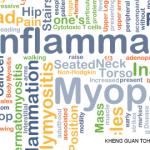The Study
The randomized, double-blind, placebo-controlled, phase 3 trial included 149 adult patients with IIM who had not previously responded to treatment. They received 125 mg of abatacept injected weekly plus standard treatment with prednisone (abatacept group) or a placebo plus prednisone (placebo group) weekly. Patients had IIM including DM, PM, IMNM or overlapping myositis. The study involved 58 clinical sites in 11 countries.
After a 24-week, double-blind period, a 28-week open-label period determined outcomes from continued therapy with abatacept in a group of placebo patients who switched to treatment with 125 mg of abatacept and usual treatment weekly.
The study’s primary end point was International Myositis Assessment and Clinical Studies (IMACS) definition of improvement at week 24. Secondary end points were efficacy and safety.
Results
In the double-blind period, 56% of the abatacept group and 42.5% of the placebo group met the IMACS definition of improvement. Analysis by IIM subtype, however, showed that observed differences between the abatacept and placebo arms were due to the improvements in PM and IMNM patients. DM patient outcomes did not differ significantly between treatment groups. Among PM and IMNM patients in the abatacept group, the response rate was 57.1% vs. 32.3% for patients in the placebo group.
Patients continuing to the open-label period demonstrated continued benefit up to week 52, regardless of original treatment group or IIM subtype. Among them, 69.8% of patients who continued abatacept and 69.0% of those who switched to abatacept from placebo improved. This result suggests a sustained benefit with abatacept up to one year.
The study failed to meet its primary objective, increasing the overall proportion of patients who met the IMACS improvement criteria (IMACS DOI) in the abatacept group, compared with the placebo group. The treatment arm’s response rate of 56% was very close to the rate expected based on prior data. But the response rate for the placebo group (42.5%) was higher than expected, leading to negative results. However, in subgroup analysis, PM/IMNM showed statistically significant improvement compared with placebo, Dr. Aggarwal notes.
Overall, these results suggest that patients with PM and IMNM subtypes may be more responsive to treatment with abatacept than DM subtypes.
Dr. Aggarwal, whose own IIM patients have benefited from abatacept, was surprised that it did not help a higher proportion of study patients. He is more pleasantly surprised with the good results in non-DM patients, especially those with IMNM, which typically is very resistant to standard of care treatment.


